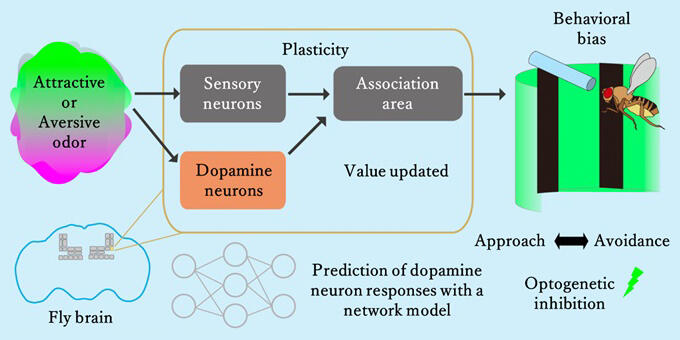A research team led by Laboratory Head Hokto Kazama and his colleagues of the Laboratory for Circuit Mechanisms of Sensory Perception at RIKEN Center for Brain Science (CBS) has discovered that dopaminergic neurons (DANs) encode the 'like' and 'dislike' of odors in organisms, and the sensory values are updated with every olfactory (i.e. smelling) experience. Applying the two-photon calcium imaging technique and image analysis to fruit flies (Drosophila), the research team succeeded in recording the activity of DANs (cells that produce dopamine, a neural signal-transmitting chemical) in all compartments of the mushroom body—an area in the fly's brain responsible for olfactory information processing. This discovery is expected to lead to the clarification of information processing mechanisms in the brain that support adaptive behavior based on brain experience. The results were published online in the international academic journal Cell Reports on September 26.

Provided by RIKEN
DANs are known to respond to rewards and punishments by driving associative learning. This is a learning process in the brain that links experiences and sensory information, such as equating a positive experience with reward and a negative experience with punishment.
The researchers observed that when odors with various innate values (as determined through previous behavioral experiments) were presented to Drosophila, some of the DANs responded more strongly to the attractive odors while others responded to the aversive odors. Subsequently, they investigated the neural circuit mechanism that generates the DANs' odor response. Their findings led them to suggest that the two olfactory pathways involved in learning-dependent and innate behaviors contribute to the generation of odor responses in these cells. They also confirmed that the repeated presentation of odors changes the DAN activity depending on the odor value and response in the cells.
Further optogenetic experiments (i.e., the use of light to control neuron activity) were performed to analyze the odor behavior of Drosophila. The results showed that when the activity of DANs responding to attractive odors was inhibited by optogenetics, the behavior became more aversive, in agreement with the activity changes of the output neurons in the mushroom body. By applying these techniques, it is expected that understanding of physiology based on anatomical data in various brain regions will advance substantially in the future.
Kazama said, "DANs are known to be involved in associative learning, which connects good or bad experiences with their associated sensory stimuli to respond to rewards and punishments. However, upon closer observation, we observed that DANs also respond to a variety of stimuli, including pleasant and unpleasant odors. Based on these results, we reached the conclusion that DANs become excited every time they receive a sensory stimulus that has value including but not limited to reward or punishment, and they update the value of that sensory stimulus themselves. We hypothesized that this might contribute to non-associative learning, which lead to our current results."
Journal Information
Publication: Cell Reports
Title: Dopaminergic neurons dynamically update sensory values during olfactory maneuver
DOI: 10.1016/j.celrep.2023.113122
This article has been translated by JST with permission from The Science News Ltd. (https://sci-news.co.jp/). Unauthorized reproduction of the article and photographs is prohibited.




